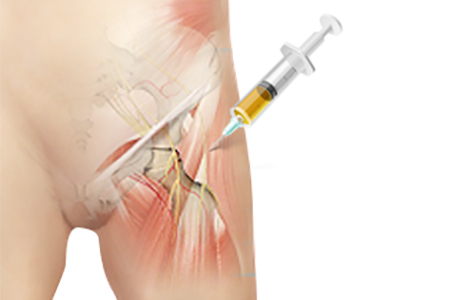What Are Platelet-Rich Plasma (PRP) Injections for the Hip?
 Platelet-rich plasma (PRP) injections for the hip are a regenerative therapy for hips to address pain and inflammation caused by conditions like hip arthritis, tendinopathies, labral tears, or other soft tissue injuries. PRP therapy involves drawing a patient's blood, processing it to concentrate the platelets, and injecting it into the affected area. The platelets, which are rich in growth factors and proteins, help promote tissue repair, reduce inflammation, and stimulate the body's natural healing process.
Platelet-rich plasma (PRP) injections for the hip are a regenerative therapy for hips to address pain and inflammation caused by conditions like hip arthritis, tendinopathies, labral tears, or other soft tissue injuries. PRP therapy involves drawing a patient's blood, processing it to concentrate the platelets, and injecting it into the affected area. The platelets, which are rich in growth factors and proteins, help promote tissue repair, reduce inflammation, and stimulate the body's natural healing process.
Indications for Platelet-Rich Plasma (PRP) Injections for the Hip Pain
PRP injections for the hip may be indicated to treat various conditions, such as:
- Hip Arthritis: Helps reduce inflammation, improve cartilage health, and alleviate hip pain.
- Hip Labral Tears: Promotes tissue repair in the damaged labrum.
- Tendon Injuries: Supports healing in tendons like the iliopsoas or gluteus medius tendons.
- Hip Bursitis: Reduces inflammation in the bursae around the hip joint.
Procedure for Platelet-Rich Plasma (PRP) Injections for the Hip
The procedure for PRP therapy for the hip is minimally invasive and typically performed under ultrasound guidance for precise delivery. The steps include:
- A small amount of blood (usually 15-50 mL) is drawn from the patient's arm.
- The blood is placed in a centrifuge, which spins at high speed to separate the components of the blood.
- Platelets are concentrated into the plasma, which contains a high level of growth factors. This forms the PRP.
- The hip joint area is sterilized to reduce the risk of infection.
- Local anesthesia may be applied to minimize discomfort during the injection.
- The PRP is injected into the targeted area—such as the hip joint, tendons, or surrounding soft tissue—under imaging guidance (ultrasound or fluoroscopy) for precise placement.
- The procedure typically takes 15-30 minutes.
Post-Procedure Care and Recovery
After a PRP injection for hip arthritis or hip pain, patients may experience mild swelling, soreness, or stiffness at the injection site for a few days as the body begins its natural healing process. Patients are usually advised to rest the treated hip for 24-48 hours and avoid strenuous activities or high-impact exercises for a few weeks. Over time, the concentrated platelets release growth factors that promote tissue repair, reduce inflammation, and improve joint function. Patients often notice progressive pain relief and improved mobility within 4-6 weeks, though the timeline may vary depending on the severity of the condition. Most patients require 1-3 injections spaced several weeks apart.
Risks and Complications
Platelet-rich plasma injections for the hip are generally considered safe, as they use the patient's own blood, minimizing the risk of allergic reactions or infections. However, like any medical procedure, there are potential risks and complications, including:
- Pain and discomfort
- Bruising
- Bleeding or hematoma
- Nerve or tissue damage
- Allergic reactions/infection (rarely)
Learn more about the PRP treatment used by Dr. Jacob here




